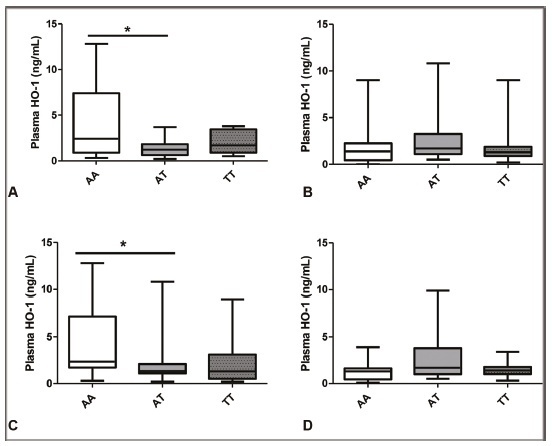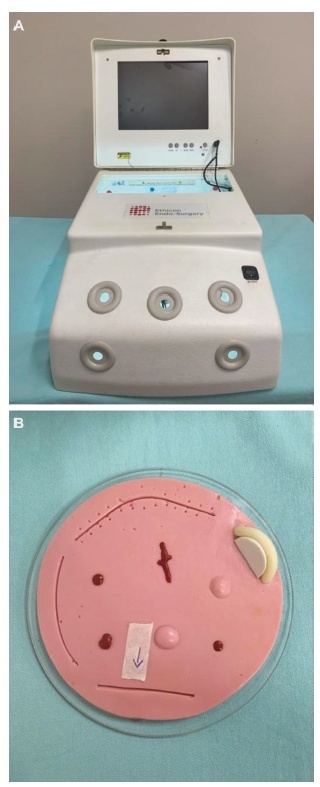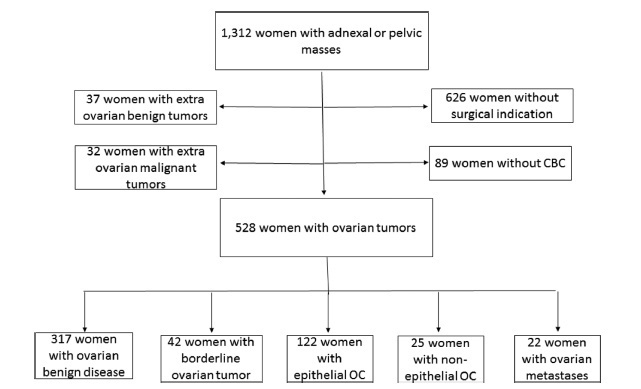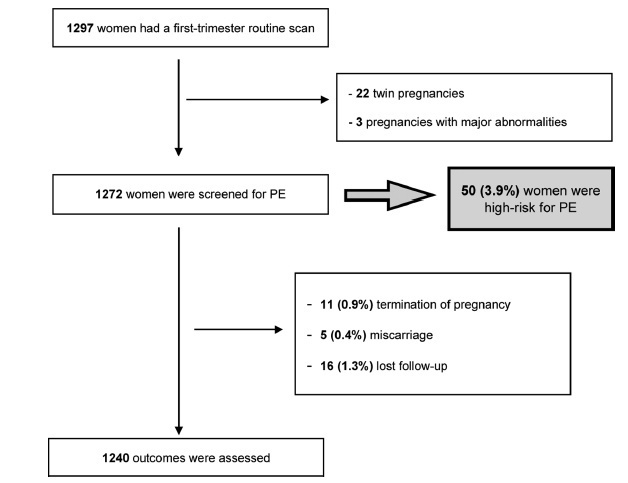Summary
Revista Brasileira de Ginecologia e Obstetrícia. 2020;42(8):460-467
We examined the interaction of polymorphisms in the genes heme oxygenase- 1 (HMOX1) and nitric oxide synthase (NOS3) in patients with preeclampsia (PE) as well as the responsiveness to methyldopa and to total antihypertensive therapy.
The genes HMOX1 (rs2071746, A/T) and NOS3 (rs1799983, G/T) were genotyped using TaqMan allele discrimination assays (Applied Biosystems, Foster City, CA, USA ), and the levels of enzyme heme oxygenase-1 (HO-1) were measured using enzyme-linked immunosorbent assay (ELISA).
We found interactions between genotypes of the HMOX-1 and NOS3 genes and responsiveness tomethyldopa and that PE genotyped as AT presents lower levels of protein HO-1 compared with AA.
We found interactions between the HMOX-1 and NOS3 genes and responsiveness to methyldopa and that the HMOX1 polymorphism affects the levels of enzyme HO-1 in responsiveness to methyldopa and to total antihypertensive therapy. These data suggest impact of the combination of these two polymorphisms on antihypertensive responsiveness in PE.

Summary
Revista Brasileira de Ginecologia e Obstetrícia. 2020;42(8):454-459
Streptococcus agalactiae is an important pathogen in neonates and pregnant women. Neonatal invasive infections due to S. agalactiae are life-threatening and preventive strategies for this challenge of human have become a concern. The aim of the present study was to determine the prevalence of rectovaginal colonization, related risk factors and antibiotic resistance pattern of S. agalactiae among pregnant women in Iran.
The present study was performed on 240 pregnant women. Vaginal and rectal swabs were obtained from all of the women and then were transferred to the laboratory. The isolation and identification of S. agalactiae was performed by standard microbiological tests and polymerase chain reaction (PCR) assay. The antimicrobial susceptibility patterns of the isolates were determined by the Kirby-Bauer disk diffusion. Polymerase chain reaction was used to detect ermB and mefA genes in erythromycin-nonsusceptible isolates.
Out of 240 pregnant women, 16 cases (6.7%) were colonized by S. agalactiae. There is no significant association between demographic-obstetric factors and maternal S. agalactiae colonization in the pregnant women. Linezolid, vancomycin and ampicillin were the most effective antibiotics against S. agalactiae. The ermB gene was present in 6 (35.29%) S. agalactiae isolates. However, the mefA gene was not detected in any of the isolates.
Given the relatively significant prevalence of S. agalactiae colonization in the pregnant women in the present study and the risk of serious neonatal infections, the screening of pregnant mothers for the bacteria seems necessary. Our findings highlight the importance of appropriate antibiotic prophylaxis during pregnancy for the prevention of early onset S. agalactiae-neonatal infection and comorbidity.
Summary
Revista Brasileira de Ginecologia e Obstetrícia. 2020;42(8):448-453
To analyze the rates of cesarean delivery longitudinally in a university hospital using the Robson classification.
Data related to births performed between 2014 and 2018 and recorded in the Maternal and Neonatal Health Information System (Sistema de Informações em Saúde Materna e Neonatal, SISMATER, in Portuguese) were analyzed using the Robson classification. As an aid, we used articles published in the last five years that approach the same topic in other Brazilian maternity hospitals; they were retrieved from the LILACS, MEDLINE, CINAHL, Scopus, Web of Science and Cochrane Library databases.
There was little variation in the total rate of cesarean sections in the period; however, the profile of each group changed over the years. It was possible to verify a significant reduction in the participation of groups of pregnant women with lower risk and an increase in high-risk pregnancies, attributable to the decrease in beds in the institution, with a greater transfer of patients. In addition, there was a reduction in cesarean sections among the lower-risk groups,while the rate among the higher-risk groups remained stable.
The use of the Robson classification to stratify cesarean deliveries contributes to a better analysis of the indications for cesarean delivery, enabling the establishment of strategies to reduce the rates, generating a positive impact on hospital management and quality of care.

Summary
Revista Brasileira de Ginecologia e Obstetrícia. 2020;42(7):404-410
To analyze the applicability and efficiency of amulti-approach laparoscopic training in improving basic laparoscopic skills of obstetrics and gynecology (OBGYN) residents.
Cross-sectional, observational and descriptive study, developed at the Experimentation and Surgery Training Center (CETEC, in the Portuguese acronym) of the Hospital Israelita Albert Einstein with OBGYN residents. Theoretical and practical tests were applied to 24 OBGYN residents to assess their laparoscopic skills before and after their participation in an 8-week course. The course involved theoretical lectures and practical laparoscopic surgery exercises developed using rubber models, black boxes, virtual simulators and animal models (pigs).
There was an overall improvement in the ability of the residents, with an increase in the number of correct answers in the theoretical evaluation and decrease in the time needed to perform practical tests (needle holder assembly and laparoscopic node). The course was evaluated by the students as highly relevant for both improving their surgical skills and motivating them to continue practicing.
Laparoscopic training using multiple approaches resulted in significant improvement of surgical skills with a high satisfaction level of the participants. Further studies are still needed to measure the long-term retention of these acquired skills.

Summary
Revista Brasileira de Ginecologia e Obstetrícia. 2020;42(7):397-403
To evaluate the diagnostic accuracy of cancer antigen 125 (CA125) and complete blood count (CBC) parameters, such as the neutrophil to lymphocyte ratio (NLR), the platelet to lymphocyte ratio (PLR), and thrombocytosis in patients with ovarian masses.
The present is a retrospective study conducted at a single tertiary hospital from January 2010 to November 2016. We included consecutive women referred due to suspicious adnexal masses. The CBC and CA125 were measured in the serum of 528 women with ovarian masses before surgery or biopsy. We evaluated the diagnostic performance of the NLR, PLR, platelets (PLTs), CA125, and the associations between them. We tested the clinical utility of the CBC parameters and CA125 in the discrimination of ovarian masses through decision curve analysis (DCA).
The best balance between sensitivity and specificity was obtained by the associations of CA125 or PLTs ≥ 350/nL, with 70.14% and 71.66%, CA125 or PLTs ≥ 400/ nL, with 67.30% and 81.79%, CA125 or PLR, with 76.3% and 64.87%, and CA125 or NLR, with 71.09% and 73.89% respectively. In the DCA, no isolated CBC parameter presented a higher clinical utility than CA125 alone.
We showed that no CBC parameter was superior to CA125 in the prediction of the malignancy of ovarian tumors in the preoperative scenario.

Summary
Revista Brasileira de Ginecologia e Obstetrícia. 2020;42(7):390-396
Preeclampsia is a major cause of perinatal and maternal morbidity and mortality. Our objective is to assess the performance of a combined screening test for preeclampsia in the first trimester and the prophylactic use of low-dose aspirin.
Prospective study of all women attending our hospital for the first-trimester screening of aneuploidies, between March 2017 and February 2018 (n = 1,297). The exclusion criteria weremultiple pregnancy andmajor fetal abnormalities. Preeclampsia screening was performed with an algorithm that includes maternal characteristics, and biophysical and biochemical biomarkers. High-risk was defined as a risk ≥ 1:50 of earlyonset preeclampsia (before 34 weeks), in which cases low-dose aspirin (150mg at night) was offered to these women from screening until 36 weeks.
From the 1,272 enrolled participants, the majority were Caucasian (1,051; 82.6%) and multiparous (658, 51.7%). Fifty patients (3.9%) screened high-risk for preeclampsia, and all started a low-dose aspirin regimen, with good compliance (96%). Early-onset preeclampsia was found in 3 pregnant women (0.24%), and total preeclampsia was diagnosed in 25 (2.02%), compared with 28 (0.75%) cases of early preeclampsia (p = 0.0099) and 98 (2.62%) of total preeclampsia (p = 0.2904) before the implementation of screening.
There was a lower incidence of both, early-onset and total preeclampsia, after the introduction of universal screening and prophylactic use of low-dose aspirin. This reduction was statistically significant in early-onset preeclampsia. The association of a first-trimester combined screening model and aspirin prophylaxis appears to be useful in predicting and reducing the incidence of early-onset preeclampsia, in a routine care setting.

Summary
Revista Brasileira de Ginecologia e Obstetrícia. 2020;42(7):380-389
To analyze the consumption of minimally-processed and ultraprocessed foods in relation with sociodemographic variables, maternal habits, educational activity received during prenatal care and clinical history.
A cross-sectional, analytical and descriptive study with 1,035 pregnant women who lives in the municipalities of the metropolitan region of Grande Vitória, Espírito Santo, Brazil (RMGV-ES), and who were hospitalized in establishments of the Unified Health System (SUS) due to childbirth (April-September 2010). The food frequency questionnaire, pregnant woman’s card and information from the medical records of the health facility unit were analyzed. The Chi-square test and the binary logistic regression model were used to investigate the association between the independent variables and the consumption of ultraprocessed foods.
It was identified that pregnant women ≤ 19 years of agewere 2.9 timesmore likely to consume ultraprocessed foods (confidence interval [CI] 95% 1.683-5.168, p< 0.001), while those ≥ 35 years old were less likely to consume them (odds ratio [OR] 0.265, 95% CI 0.105-0.666, p= 0.005). Maternal smoking increased the odds of consumption of ultraprocessed foods by 2.2 times (95% CI 1.202-4.199, p= 0.011) and pregnant womenwho did not obtain information on healthy food during prenatal care presented 54.1% less chances of consuming minimally-processed foods (OR 0.459, 95% CI 0.307-0.687, p< 0.001).
Smoking during the gestational period and being a teenager are factors that influence the consumption of ultraprocessed foods of pregnant women. Race/ color, head of household, age group, receiving of information about feeding in the prenatal period and not having smoked in gestation determined the consumption of minimally-processed foods.
Summary
Revista Brasileira de Ginecologia e Obstetrícia. 2020;42(7):373-379
To investigate the patterns of hospital births in the state of Rio de Janeiro (RJ), Brazil, between 2015 and 2016; considering the classification of obstetric characteristics proposed by Robson and the prenatal care index proposed by Kotelchuck.
Data obtained from the Information System on Live Births of the Informatics Department of the Brazilian Unified Health System (SINASC/DATASUS, in the Portuguese acronym) databases were used to group pregnant women relatively to the Robson classification. A descriptive analysis was performed for each Robson group, considering the variables: maternal age, marital status, schooling, parity, Kotelchuck prenatal adequacy index and gestational age. A logistic model estimated odds ratios (ORs) for cesarean sections (C-sections), considering the aforementioned variables.
Out of the 456,089 live births in Rio de Janeiro state between 2015 and 2016, 391,961 records were retained, 60.3% of which were C-sections. Most pregnant women (58.6%) were classified in groups 5, 2 or 3. The percentage of C-sections in the Robson groups 1, 2, 3, 4, 5 and 8 was much higher than expected. Prenatal care proved to be inadequate for women who subsequently had a vaginal delivery, had an unfavorable family structure and a lower socioeconomic status (mothers without partners and with lower schooling), compared with those undergoing cesarean delivery. For a sameRobson group, the chance of C-section increases when maternal age rises (OR = 3.33 for 41-45 years old), there is the presence of a partner (OR = 1.81) and prenatal care improves (OR = 3.19 for “adequate plus”).
There are indications that in the state of RJ, from 2015 to 2016, many cesarean deliveries were performed due to nonclinical factors.